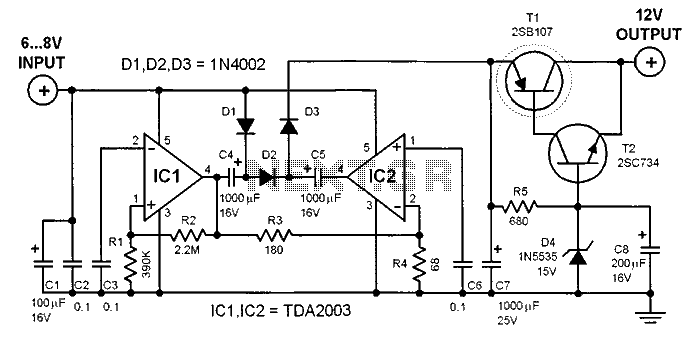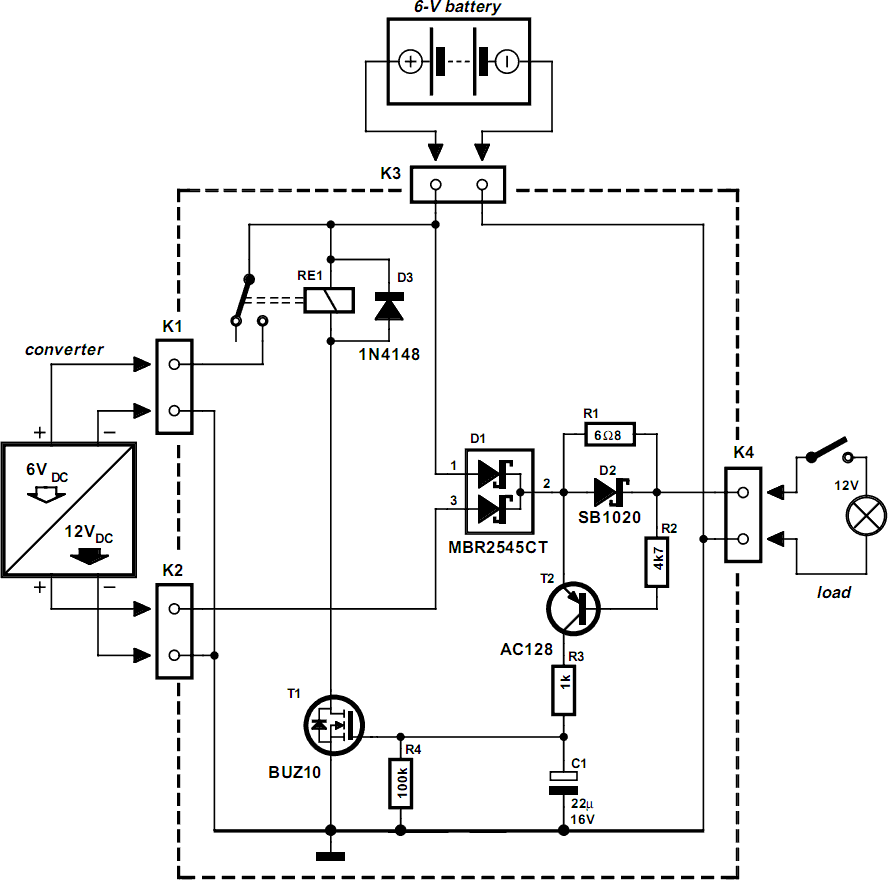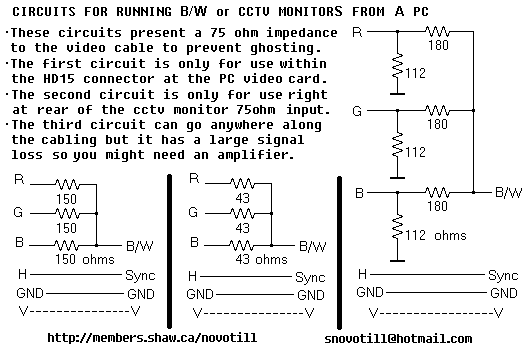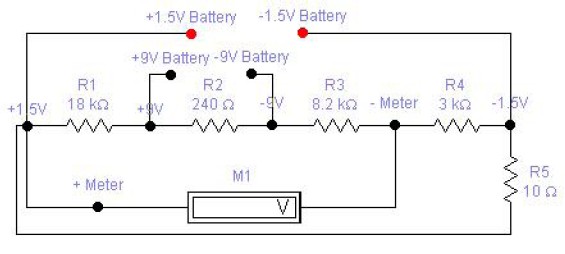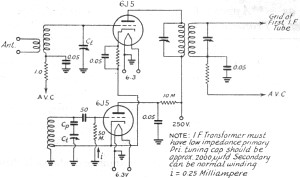
1.5V to 5V/12V DC/DC Converter with LT1073
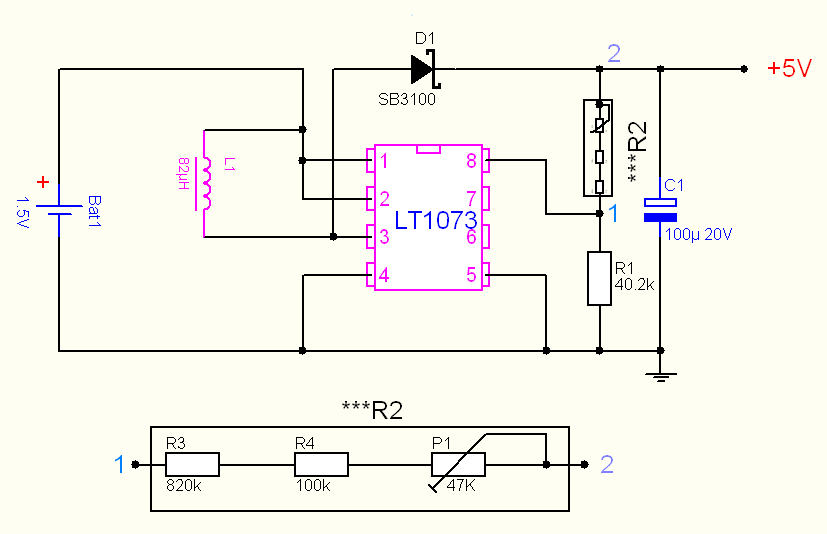
A compact DC/DC converter designed to provide either 5V or 12V output using the LT1073 integrated circuit (IC). This IC is available in three versions based on the desired output voltage, with two options providing fixed outputs of 5V and 12V, and a third adjustable version. The output voltage can be modified using a voltage divider composed of two resistors connected to the output terminal and Terminal 8, which is internally linked to the voltage comparator IC responsible for maintaining output stability. Constructing the inductive part of the circuit may be complex without a meter inductance, but several solutions exist. The recommended capacitor for this circuit may be difficult to source; however, a tantalum capacitor salvaged from another power source can be used, yielding low ripple voltage at the output. It is crucial to use a fast diode; the 1N4002 rectifier is not suitable, while the 1N5818 Schottky diode is recommended due to its rapid response time and low internal resistance, making it ideal for this type of converter. The circuit photograph shows a low-energy lamp with a small toroidal core that can be repurposed. A core with an inductance of 82 H can be wound with 7 turns of 0.3mm enameled copper wire. Alternatively, a Ferroxcube toroidal core (Farnell code 178-504) measuring 13.25 x 7.35 x 5.7mm, grade 3C85, with an AL value of 1000 can be used, requiring 8 turns to achieve 90 H. Comprehensive documentation is available on the manufacturer's website, offering numerous application examples and clear instructions.
The LT1073 DC/DC converter circuit is designed to efficiently convert input voltages to stable output levels of either 5V or 12V, depending on the selected version of the IC. The adjustable version allows for fine-tuning of the output voltage, making it versatile for various applications. The voltage divider configuration consists of two resistors that establish a feedback loop to the voltage comparator, which ensures that the output voltage remains constant despite variations in load or input voltage.
For the inductive component, the selection of the core is critical. The use of a toroidal core minimizes electromagnetic interference and provides better efficiency. The suggested winding of 7 turns on an 82 H core or 8 turns on a Ferroxcube core demonstrates the adaptability of the design to different core materials and dimensions. The choice of wire gauge, specifically 0.3mm enameled copper wire, is suitable for the current levels expected in this application, ensuring minimal resistive losses.
The capacitor selection is also essential, as it influences the output voltage ripple. While sourcing the recommended capacitor can pose challenges, utilizing a salvaged tantalum capacitor maintains performance standards. The ripple voltage should be monitored to ensure that it remains within acceptable limits for sensitive electronic devices.
The diode selection is another pivotal aspect of the circuit design. The 1N5818 Schottky diode is preferred due to its quick switching capabilities, which enhance the overall efficiency of the converter. The faster recovery time reduces the chances of voltage spikes that could potentially damage downstream components.
Overall, the LT1073 DC/DC converter circuit exemplifies a well-structured approach to voltage regulation, leveraging adjustable output features, careful component selection, and robust design principles to achieve reliable performance across various applications. The availability of comprehensive documentation further supports users in implementing the circuit effectively.Small 1. 5V to 5V or 12V DC/DC converter with LT1073 chip. The IC is available in three different versions, depending on output voltage. Two with fixed output voltage of 5V and 12V, and the most interesting that can be adjusted. The adjustment is done through a voltage divider with two resistors, of mass, output and Terminal 8, internally connected to the voltage comparator IC, which is responsible for stabilizing the output voltage. If you do not have a meter inductance, the inductive part of the drive is a bit more complicated to make, but we shall see some possible solutions. Capacitor also recommended by the manufacturer for the circuit is a bit hard to get, I have used a tantalum recovered from another power source, and the ripple voltage at the output is quite low.
Last but not least, say that the diode has to be a fast, not worth as the 1N4002 rectifiers, the 1N5818 is recommended schottky type, characterized by high response time and low internal resistance, which is what ideal for this type of converters. As we can see from the photograph of the circuit in a low energy lamp, ay a small toroidal core can be recovered.
82 H To this core, we winding 7 turns of 0. 3mm enamelled copper wire. Another option is to use a toroidal core Ferroxcube, Farnell code 178-504 of 13. 25 x7, 35x5, 7mm, grade 3C85, value AL 1000. with this core we have winding 8 turns to 90 H. Finally, note that you can download the documentation in the manufacturer`s website, is very good and complete, with numerous examples of applications, and above all very clear. 🔗 External reference
The LT1073 DC/DC converter circuit is designed to efficiently convert input voltages to stable output levels of either 5V or 12V, depending on the selected version of the IC. The adjustable version allows for fine-tuning of the output voltage, making it versatile for various applications. The voltage divider configuration consists of two resistors that establish a feedback loop to the voltage comparator, which ensures that the output voltage remains constant despite variations in load or input voltage.
For the inductive component, the selection of the core is critical. The use of a toroidal core minimizes electromagnetic interference and provides better efficiency. The suggested winding of 7 turns on an 82 H core or 8 turns on a Ferroxcube core demonstrates the adaptability of the design to different core materials and dimensions. The choice of wire gauge, specifically 0.3mm enameled copper wire, is suitable for the current levels expected in this application, ensuring minimal resistive losses.
The capacitor selection is also essential, as it influences the output voltage ripple. While sourcing the recommended capacitor can pose challenges, utilizing a salvaged tantalum capacitor maintains performance standards. The ripple voltage should be monitored to ensure that it remains within acceptable limits for sensitive electronic devices.
The diode selection is another pivotal aspect of the circuit design. The 1N5818 Schottky diode is preferred due to its quick switching capabilities, which enhance the overall efficiency of the converter. The faster recovery time reduces the chances of voltage spikes that could potentially damage downstream components.
Overall, the LT1073 DC/DC converter circuit exemplifies a well-structured approach to voltage regulation, leveraging adjustable output features, careful component selection, and robust design principles to achieve reliable performance across various applications. The availability of comprehensive documentation further supports users in implementing the circuit effectively.Small 1. 5V to 5V or 12V DC/DC converter with LT1073 chip. The IC is available in three different versions, depending on output voltage. Two with fixed output voltage of 5V and 12V, and the most interesting that can be adjusted. The adjustment is done through a voltage divider with two resistors, of mass, output and Terminal 8, internally connected to the voltage comparator IC, which is responsible for stabilizing the output voltage. If you do not have a meter inductance, the inductive part of the drive is a bit more complicated to make, but we shall see some possible solutions. Capacitor also recommended by the manufacturer for the circuit is a bit hard to get, I have used a tantalum recovered from another power source, and the ripple voltage at the output is quite low.
Last but not least, say that the diode has to be a fast, not worth as the 1N4002 rectifiers, the 1N5818 is recommended schottky type, characterized by high response time and low internal resistance, which is what ideal for this type of converters. As we can see from the photograph of the circuit in a low energy lamp, ay a small toroidal core can be recovered.
82 H To this core, we winding 7 turns of 0. 3mm enamelled copper wire. Another option is to use a toroidal core Ferroxcube, Farnell code 178-504 of 13. 25 x7, 35x5, 7mm, grade 3C85, value AL 1000. with this core we have winding 8 turns to 90 H. Finally, note that you can download the documentation in the manufacturer`s website, is very good and complete, with numerous examples of applications, and above all very clear. 🔗 External reference
